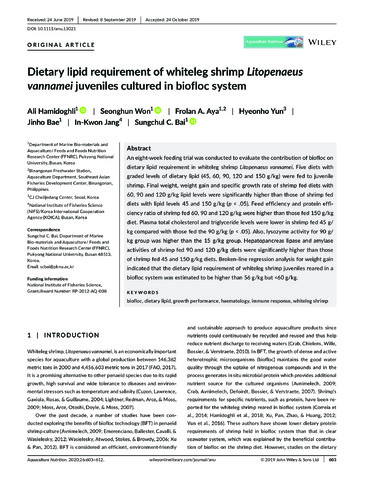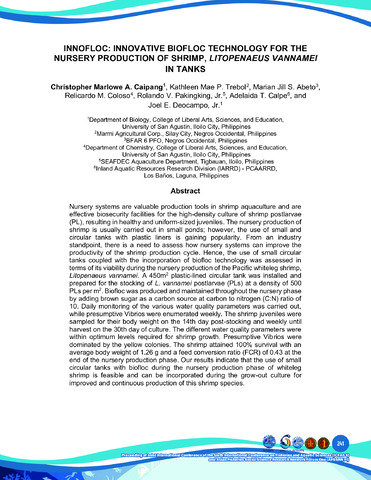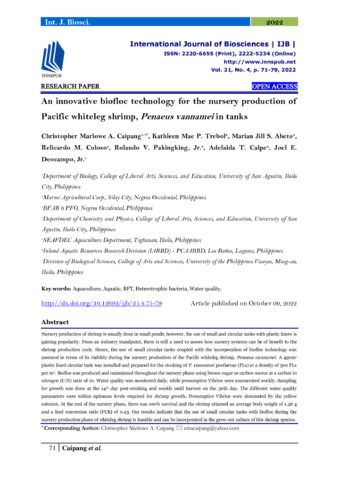Dietary lipid requirement of whiteleg shrimp Litopenaeus vannamei juveniles cultured in biofloc system
Share
抄録
An eight-week feeding trial was conducted to evaluate the contribution of biofloc on dietary lipid requirement in whiteleg shrimp Litopenaeus vannamei. Five diets with graded levels of dietary lipid (45, 60, 90, 120 and 150 g/kg) were fed to juvenile shrimp. Final weight, weight gain and specific growth rate of shrimp fed diets with 60, 90 and 120 g/kg lipid levels were significantly higher than those of shrimp fed diets with lipid levels 45 and 150 g/kg (p < .05). Feed efficiency and protein efficiency ratio of shrimp fed 60, 90 and 120 g/kg were higher than those fed 150 g/kg diet. Plasma total cholesterol and triglyceride levels were lower in shrimp fed 45 g/kg compared with those fed the 90 g/kg (p < .05). Also, lysozyme activity for 90 g/kg group was higher than the 15 g/kg group. Hepatopancreas lipase and amylase activities of shrimp fed 90 and 120 g/kg diets were significantly higher than those of shrimp fed 45 and 150 g/kg diets. Broken-line regression analysis for weight gain indicated that the dietary lipid requirement of whiteleg shrimp juveniles reared in a biofloc system was estimated to be higher than 56 g/kg but <60 g/kg.
Suggested Citation
Hamidoghli, A., Won, S., Aya, F., Yun, H., Bae, J., Jang, I.-K., & Bai, S. C. (2020). Dietary lipid requirement of whiteleg shrimp Litopenaeus vannamei juveniles cultured in biofloc system. Aquaculture Nutrition , 26(3), 603-612. https://doi.org/10.1111/anu.13021
主題
Taxonomic term
Collections
- AQD Journal Articles [1249]
Related items
Showing items related by title, author, creator and subject.
-
Innofloc: Innovative biofloc technology for the nursery production of shrimp, Litopenaeus vannamei in tanks
Caipang, Christopher Marlowe; Trebol, Kathleen Mae P.; Abeto, Marian Jill S.; Coloso, Relicardo M.; Pakingking, Rolando; Calpe, Adelaida T.; Deocampo Jr., Joel E. (University of the Philippines Visayas, 2022)Nursery systems are valuable production tools in shrimp aquaculture and are effective biosecurity facilities for the high-density culture of shrimp postlarvae (PL), resulting in healthy and uniform-sized juveniles. The ... -
An innovative biofloc technology for the nursery production of Pacific whiteleg shrimp, Penaeus vannamei in tanks
Caipang, Christopher Marlowe; Trebol, Kathleen Mae P.; Abeto, Marian Jill S.; Coloso, Relicardo M.; Pakingking, Rolando V., Jr.; Calpe, Adelaida T.; Deocampo, Joel E., Jr. (International Network for Natural Sciences, 2022-10-09)Nursery production of shrimp is usually done in small ponds; however, the use of small and circular tanks with plastic liners is gaining popularity. From an industry standpoint, there is still a need to assess how nursery ... -
Biofloc-based nursery production system: Heeding the call towards a sustainable shrimp culture industry in the Philippines
Caipang, Christopher Marlowe; Trebol, Kathleen Mae P.; Fagutao, Fernand; Pakingking, Rolando V., Jr.; Deocampo, Joel E., Jr. (International Network for Natural Sciences, 2022)The increasing global population resulted in intense pressure on the food production sectors to meet the rise in food demand. The aquaculture industry, which is one of the major food production sectors, provides opportunities ...




